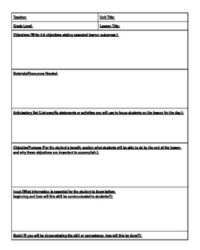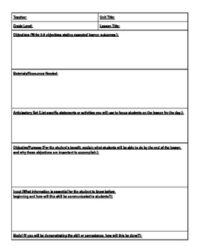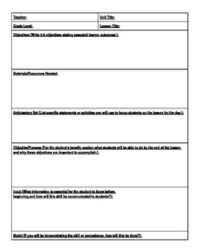Every educator knows that a well-crafted lesson plan is the backbone of effective teaching. It’s more than just an outline; it’s a roadmap that guides both the teacher and the students through the learning journey, ensuring that objectives are met and understanding is solidified. Without a clear plan, even the most experienced teachers can find themselves adrift, making it harder to engage students or measure progress.
Among the many pedagogical frameworks available, the Hunter Model stands out for its structured and sequential approach to lesson design. Developed by Dr. Madeline Hunter, this model provides a comprehensive guide for teachers to plan and deliver lessons that are clear, engaging, and highly effective. Utilizing a hunter model lesson plan template can significantly streamline this process, offering a consistent and reliable structure to ensure all crucial elements are addressed.
Understanding the Hunter Model Framework
The Hunter Model is built upon the premise that effective instruction follows a logical progression, designed to maximize student learning. It breaks down the teaching process into seven key components, each serving a distinct purpose in facilitating understanding and retention. While the model provides a robust framework, its genius lies in its adaptability, allowing educators to tailor it to various subjects, grade levels, and learning styles. It’s not a rigid script, but rather a flexible blueprint for thoughtful instruction.
At its core, the model begins with setting the stage for learning and clearly defining what students will achieve. It then moves into the core delivery of content, followed by crucial opportunities for students to practice new skills and for teachers to assess comprehension. This systematic approach ensures that every step of the lesson contributes meaningfully to the overall learning objective, building knowledge and skills progressively.
For those new to the Hunter Model, or even seasoned professionals looking for consistency, a well-designed hunter model lesson plan template becomes an invaluable tool. It acts as a checklist, reminding you to include all seven essential components, from the initial hook that grabs attention to the final activity that reinforces learning. This structured format helps prevent oversights and ensures a holistic approach to lesson design.
Let’s briefly explore a few of the core components that make this model so powerful:
Anticipatory Set
This is your lesson’s hook! It’s designed to grab students’ attention, activate their prior knowledge, and get them mentally ready for the lesson. Think of it as a warm-up exercise for the brain. It could be a thought-provoking question, a short video, a quick activity, or a real-world scenario that connects to the topic at hand. A strong anticipatory set primes students for learning and creates curiosity.
Objective
Clearly stating the lesson’s objective is paramount. What exactly should students be able to know, understand, or do by the end of the lesson? Objectives should be specific, measurable, achievable, relevant, and time-bound (SMART). Communicating these objectives to students at the outset provides them with a clear purpose and direction for their learning.
Guided Practice and Checking for Understanding
These two components often work hand-in-hand. After direct instruction, guided practice allows students to apply new information or skills with teacher support. This is where you might work through problems together or complete activities in small groups. Checking for understanding is woven throughout this stage, allowing you to gauge whether students are grasping the concepts before moving on. This continuous feedback loop is crucial for adjusting your instruction in real-time.
Crafting Your Effective Hunter Model Lesson Plan
Once you understand the components, the next step is to effectively fill out your hunter model lesson plan template. This isn’t just about ticking boxes; it’s about thoughtful planning that anticipates student needs and potential challenges. Begin by defining your clear learning objective – what do you want students to achieve? From there, brainstorm engaging anticipatory sets, design direct instruction that is concise and clear, and create opportunities for both supported and independent practice. The more detail you put into your template, the smoother your lesson delivery will be.
An effective template encourages you to consider the pacing of your lesson, how you will transition between activities, and what resources you will need. It prompts you to think about differentiation – how will you support struggling learners and challenge those who grasp concepts quickly? By systematically planning each phase, you ensure that every minute of your instruction is purposeful and contributes to student success. This foresight saves valuable class time and reduces stress for both you and your students.
Using a structured template offers numerous benefits that extend beyond just lesson delivery. It promotes consistency in your teaching approach, making it easier to reflect on what worked well and what could be improved. It also provides a clear record of your curriculum coverage, which can be invaluable for school administration or parent-teacher conferences. Here are some key benefits:
- Ensures comprehensive lesson planning, covering all critical stages.
- Promotes a student-centered approach by focusing on objectives and practice.
- Facilitates effective time management during instruction.
- Provides a clear framework for substitute teachers to follow.
- Supports reflective practice and continuous improvement in teaching.
Embracing the Hunter Model lesson plan template can truly revolutionize your approach to teaching. It provides a robust, research-backed structure that helps you design lessons that are not only engaging and clear but also highly effective in achieving learning outcomes. By systematically planning each stage of instruction, you empower your students to build knowledge and skills with confidence, fostering a more dynamic and productive learning environment.
Ultimately, a well-utilized template becomes more than just a document; it transforms into a powerful tool for professional growth and student success. It simplifies the complex task of lesson design, allowing educators to focus more on the art of teaching and less on the mechanics of planning. Dive in, experiment, and see how this structured approach can elevate your classroom experience.


